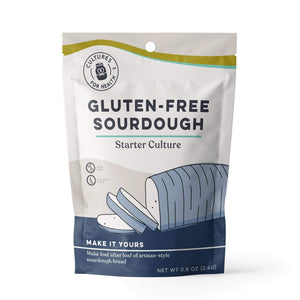
These flour-and-egg noodles are a great replacement for the usual lasagna, fettuccine, or other favorite pasta. Working with gluten-free dough can be a little bit tricky, so take your time with the rolling and cutting steps. It may take time and patience, but this fresh pasta is well worth the wait!
20 minutes
180 minutes
4
INGREDIENTS AND EQUIPMENT AVAILABLE AT CULTURES FOR HEALTH
Gluten-Free Sourdough Starter

Gluten-Free Sourdough Starter Culture
$14.99
Not eating gluten? No problem! With the help of our gluten free sourdough starter culture, you can make tangy, fluffy sourdough bread that’s gluten-free.
The GF sourdough starter is an heirloom culture, meaning you'll make endless bread dough all from one starter! Just add water and gluten-free flour.
Sourdough is perfect for beginners, and this gluten free sourdough bread starter is a very forgiving culture and one of the easiest to work with.
INGREDIENTS:
- ¾ cup millet flour
- ¾ cup oat flour
- ½ cup potato starch, plus more for rolling
- 2 tsp. xanthan gum
- 1 whole egg
- 2 egg yolks
- 1 Tbsp. olive oil
- ¼ cup gluten-free sourdough starter
INSTRUCTIONS:
- Combine the millet flour, oat flour, potato starch, and xanthan gum in a large bowl. Whisk well to combine and then make a well, in the center of the dry ingredients. Add the egg, egg yolks, olive oil, and gluten-free sourdough starter to the well. Whisk wet ingredients and begin pulling in dry ingredients.
- Mix all ingredients together until a stiff but moist dough forms. Gently flour a clean work surface with potato starch and turn dough out onto it. Knead dough several times or until it is smooth, adding more flour as necessary to keep it from sticking.
- Return dough to bowl and cover tightly. Allow dough to ferment at room temperature for 6-24 hours. A longer fermentation will break down the flour more and create a more pronounced sourdough flavor. During the fermentation period, the dough should be kneaded and recovered approximately every 8 hours.
- When ready to cook, bring a large pot of water to a boil over medium heat. Meanwhile, knead fermented dough a few times and prepare to roll
- To roll pasta by hand, place a sheet of parchment paper on a work surface and sprinkle lightly with potato starch. Divide the dough in half and place one half on top of the first sheet of parchment. Flatten the dough out into a workable size, sprinkle lightly with potato starch, and cover dough with a second sheet of parchment paper.
- If using a rolling pin, roll dough as thinly as possible into desired shape. Once rolled, cut noodles into long strips for fettuccine, long rectangles for lasagna, or squares for ravioli.
- To cook, make sure water is at a rolling boil and add a small handful of sea salt. Carefully transfer noodles to pot, separating them as you go, if needed. Boil for approximately 5 minutes, or until al dente.
- While pasta is boiling, repeat rolling process with the second half of the pasta dough. Cut and cook the same way as the first batch.
Serve with simply butter and seasonings or with your favorite sauce.
















